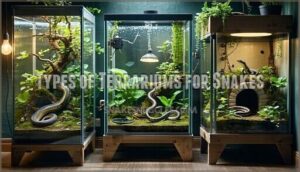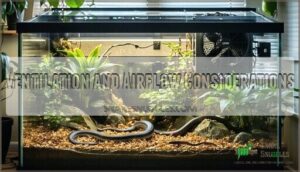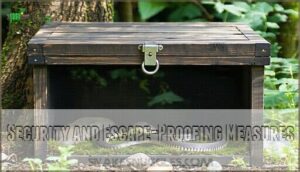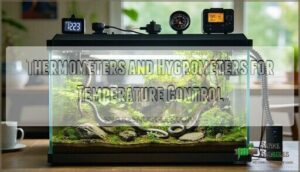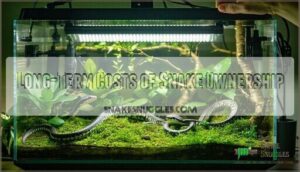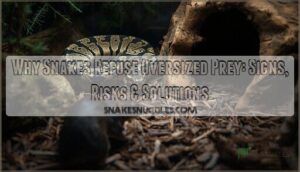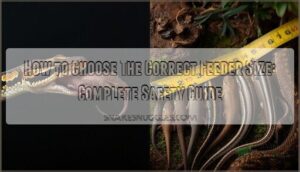This site is supported by our readers. We may earn a commission, at no cost to you, if you purchase through links.

A 40-gallon tank runs $50-100, while heating pads and ceramic heaters add $30-80.
Don’t forget the thermostat ($25-50) – it’s your snake’s lifeline for temperature control.
Monthly expenses hit $15-30 for electricity and substrate replacement.
Larger species need bigger enclosures, pushing costs higher.
The real sticker shock? That "starter kit" rarely includes everything you actually need for a thriving serpent setup, which can be a lifeline for your snake, and understanding these costs is key to avoiding temperature control issues.
Table Of Contents
- Key Takeaways
- Snake Housing Costs Explained
- Choosing The Right Snake Enclosure
- Essential Equipment for Snake Housing
- Snake Housing Size and Space Requirements
- Long-Term Costs of Snake Ownership
- Frequently Asked Questions (FAQs)
- How expensive is owning a snake?
- How expensive is it to keep snakes?
- How much does it cost to set up a snake?
- How much does it cost to get a snake out of your house?
- How much does it cost to house a snake?
- What type of housing does a snake need?
- How long do house pet snakes live?
- How much room does a snake need?
- How often should I clean my snakes enclosure?
- Can I use household items for snake hides?
- Conclusion
Key Takeaways
- You’ll spend $150-400 initially on your snake’s housing setup, including terrarium, heating equipment, and substrate – but don’t expect starter kits to include everything you actually need
- Monthly costs run $15-30 for electricity and substrate replacement, with annual expenses totaling $200-500 for food and heating, and maintenance throughout your snake’s lifetime
- A quality thermostat ($25-50) isn’t optional equipment – it’s essential for preventing dangerous temperature fluctuations that can harm or kill your snake
- Plan for growth by choosing larger enclosures early, as upgrade costs of $100-300 hit when your snake outgrows its starter home
Snake Housing Costs Explained
Setting up a snake’s home costs between $300-$500 initially.
This initial cost is just the beginning, as you’ll also face ongoing expenses like heating, substrate, and food that add up to $200-$500 yearly.
Understanding these costs upfront helps you budget properly and avoid sticker shock when your scaly friend needs a bigger house or that monthly bag of frozen mice.
Initial Setup Costs for a Snake Terrarium
Setting up your snake’s initial setup will cost $250–$600 for most species.
Terrarium costs range from $100–$350 for glass or PVC enclosure materials, while snake purchase prices vary $30–$200.
Heating options add $60–$150 to your budget planning.
Snake housing cost includes thermostats, substrate, and décor.
Snake enclosure cost depends on size—snake tank prices increase with your pet’s adult dimensions.
Reptile enclosure prices reflect quality and features you’ll need long-term.
Understanding vivarium setup costs is essential for planning and maintaining a suitable environment for your pet snake.
Ongoing Expenses for Heating and Lighting
You’ll face monthly heating costs of $5-$15 for a single snake enclosure, with annual expenses reaching $50-$100.
Heat lamps consume about $5 monthly when running 12 hours daily, while heating pads add just $1-$3.
Thermostats cut energy use by 30-50%, delivering real energy savings through smart temperature control.
Understanding the total snake ownership costs is vital for preparing a suitable environment.
Essential heating and lighting considerations:
- Heat lamps require replacement every 6-8 months, but LED options last longer
- Heating pad systems offer the most cost-effective snake heating options
- UVB light isn’t always necessary, saving you money on lighting expenses
Substrate and Humidity Control Costs
Snake substrate costs typically run $10-$20 per bag every 2-3 months. Aspen shavings are budget-friendly at $10 but need monthly replacement. Orchid bark costs $15 and lasts longer.
For humidity control, you’ll need water bowls ($5-$15) and heating pads ($10-$25) to maintain proper moisture levels. Sphagnum moss works great for humidity-loving species but costs $20 per bag.
Regular substrate replacement keeps your snake healthy and your enclosure fresh. Proper snake housing substrate selection is essential for maintaining a healthy environment.
Upgrading to a Larger Enclosure
Your snake’s growth means enclosure size matters more than you think!
Your pet outgrows its starter home, and upgrade costs range from $100-$300.
Plan for snake growth by choosing larger terrariums early—aim for 10 gallons of tank volume per foot of snake length.
Smart snake enclosure expansion saves money and stress later!
Choosing The Right Snake Enclosure
Choosing the right snake enclosure means balancing your pet’s needs with your budget, space, and long-term plans.
You don’t want your snake outgrowing its home faster than you can say “shed skin,” so it’s smart to look at size, materials, and safety from the start.
Types of Terrariums for Snakes
When you’re selecting your snake’s home, you’ll discover several terrarium options that balance cost with functionality.
Each type offers distinct advantages for different budgets and snake species.
Glass Terrariums provide excellent visibility and easy cleaning, while Wooden Vivariums offer superior insulation.
PVC Enclosures resist humidity damage better than traditional materials.
- Glass Terrariums ($75-$300) – Perfect visibility, easy maintenance, widely available
- Wooden Vivariums ($50-$250) – Natural aesthetics, excellent insulation, customizable features
- PVC Enclosures ($389-$1,434) – Humidity-resistant, lightweight, professional-grade durability
Bioactive Terrariums and Modular Cages offer specialized solutions for advanced keepers.
The quality of glass terrarium products can substantially impact the overall health and well-being of your snake.
Size and Space Requirements for Snakes
Getting the proper snake enclosure size isn’t rocket science, but it’s essential for your pet’s wellbeing. Your snake length determines the baseline minimum tank size – aim for enclosures where length plus width equals your snake’s total body length.
Most species thrive with adequate vertical space for movement and climbing structures for enrichment.
Consider these snake species size requirements:
- Hatchlings: 10-gallon tanks work temporarily, but plan upgrades
- Juveniles: 36" x 18" x 18" provides growing room
- Adults: 4′ x 2′ x 2′ minimum for most common species
- Giants: Custom enclosures or dedicated rooms for large pythons
Enclosure depth matters too – deeper tanks allow better temperature gradients and more natural behaviors.
Ventilation and Airflow Considerations
Multiple ventilation points create healthy airflow that prevents dangerous humidity buildup and maintains proper oxygen levels in your snake’s home.
Breathable materials and ventilation systems work together to guarantee consistent air exchange throughout the enclosure.
| Ventilation Type | Airflow Control | Cost Range |
|---|---|---|
| Screen tops | Basic passive flow | $15-$40 |
| Side vents | Moderate circulation | $25-$60 |
| Fan systems | Active snake enclosure airflow | $50-$120 |
| Custom mesh | Adjustable snake enclosure ventilation | $30-$85 |
Poor ventilation creates stagnant air pockets that encourage harmful bacteria growth and respiratory issues.
Security and Escape-Proofing Measures
Beyond proper ventilation, you’ll need rock-solid snake enclosure security to prevent costly escapes. Snakeproofing your setup means addressing every potential weakness before disaster strikes.
Here’s your escape prevention checklist:
- Secure lids with locking mechanisms that can’t pop open under pressure
- Enclosure seals around all joints and corners to eliminate gaps
- Heavy-duty latches that require deliberate action to open
- Snake enclosure weak spots like ventilation screens reinforced with fine mesh
- Regular inspections of your snake enclosure locking mechanism for wear
Remember, snakes are escape artists who’ll exploit any weakness in your setup.
Essential Equipment for Snake Housing
Beyond the enclosure itself, you’ll need specific equipment to maintain your snake’s health and comfort.
Essential items include heating elements, temperature monitoring tools, humidity control systems, and appropriate substrate materials that work together to create a proper habitat.
Heating and Lighting Options for Snakes
The right heat sources and lighting options create your snake’s perfect environment.
Heat lamps provide basking spots while ceramic emitters maintain nighttime warmth without light.
UVB light supports natural behaviors and health for many species.
Install thermostat settings to prevent overheating – your snake’s safety depends on precise temperature control.
A reliable heat source paired with proper heating and lighting keeps your pet thriving year-round.
For effective snake care, understanding heat lamp systems is vital for maintaining the right environment.
Thermometers and Hygrometers for Temperature Control
Temperature Sensors and hygrometers are your snake’s health monitors.
Digital thermometers with probe capabilities track Heat Sources accurately, while hygrometers measure Humidity Control levels.
Place sensors away from direct heat lamps for reliable readings.
Quality Climate Monitoring equipment prevents temperature spikes that stress snakes.
Thermostat Settings work best with dual-zone monitoring systems.
For accurate temperature readings, investing in a reliable digital thermometer deviceDigital Thermometer is essential for maintaining a stable environment.
Humidity Gauges and Misting Systems
Proper humidity control keeps your snake healthy and comfortable in their home.
You’ll need reliable hygrometers to monitor moisture levels, while misting systems and foggers help maintain ideal conditions automatically.
Essential humidity equipment includes:
- Hygrometers – Your snake’s moisture meter that prevents respiratory issues
- Misting systems – Automated sprinklers that save you daily maintenance headaches
- Foggers – Gentle humidity boosters that create natural rainforest vibes.
Digital hygrometers cost $10-30 and provide accurate readings for snake enclosure humidity monitoring.
Automatic misting systems range from $50-200 but they’re worth every penny for consistent reptile vivarium cost management.
Substrate and Decorations for a Natural Environment
With your humidity dialed in, you’ll want to create a cozy home with the right substrate and decorations.
Choose substrate options like aspen shavings or cypress mulch that hold moisture without getting moldy. Add decorative rocks, natural plants, and multiple hide boxes to mimic your snake’s wild habitat.
Understanding the importance of snake housing substrate is essential for creating a healthy environment.
| Substrate Types | Cost Range |
|---|---|
| Aspen Shavings | $10-15/bag |
| Cypress Mulch | $12-18/bag |
| Coconut Fiber | $8-12/bag |
| Paper Towels | $5-8/pack |
| Orchid Bark | $15-25/bag |
Water features and natural environment elements like driftwood create authentic snake hiding places that reduce stress.
Snake Housing Size and Space Requirements
Getting your snake’s housing size right prevents expensive upgrades later and keeps your pet healthy throughout its life.
You’ll need to take into account both your snake’s current size and its adult dimensions when choosing an enclosure.
Minimum Tank Size Recommendations for Snakes
When selecting a snake enclosure, you’ll need specific minimum tank size requirements.
Adult snakes under 4 feet require at least a 40-gallon tank with proper enclosure dimensions.
Your snake habitat should provide one square foot of floor space per foot of snake length.
Consider space requirements carefully – a minimum tank size calculator helps determine ideal enclosure depth and ventilation needs for your species.
Ensuring proper tank size calculations is essential for creating a healthy environment for your pet snake, with proper tank size and ventilation needs, and using a minimum tank size calculator.
Calculating The Ideal Enclosure Size for Your Snake
Beyond the basic rule of thumb, you’ll want to calculate your snake’s ideal home using specific measurements that account for growth and behavior.
Most species thrive when their enclosure length equals their snake length, while width should be at least one-third of their body length.
- Snake Length: Measure your adult snake from nose to tail tip for accurate sizing
- Enclosure Depth: Provide width that’s 30-50% of your snake’s total length
- Tank Volume: Use the 10-gallon-per-foot rule as your starting baseline
- Space Requirements: Factor in hiding spots, water bowls, and movement areas
- Scaling Up: Plan for juvenile growth spurts to avoid frequent upgrades
Think of it like buying shoes – you wouldn’t squeeze into a size too small, and your snake shouldn’t either.
A proper enclosure size calculator considers both current dimensions and future growth, helping you avoid costly mistakes.
Remember, cramped quarters lead to stressed snakes and higher vet bills down the road.
Vertical Space and Climbing Structures for Snakes
Arboreal snakes thrive with vertical space and climbing structures that mimic their natural habitat.
Install climbing walls with textured surfaces and branch supports at varying heights.
Snake ladders and vertical nets provide additional climbing opportunities, while rock formations create realistic terrain.
Space snake climbing structures 6-8 inches apart for comfortable movement through your snake enclosure decoration.
Providing Hiding Places and Visual Barriers
After setting up vertical space, your snake needs secure hiding spots and visual barriers to feel safe in its new home.
Think of it like creating a cozy bedroom where your snake can retreat when it needs privacy or feels stressed.
Here are essential hiding places and visual barriers to include:
- Snake hides – Commercial caves or DIY hideouts for secure resting spots
- Decorative rocks – Natural-looking stones that double as hiding places
- Plant covers – Artificial or live plants that create visual barriers
- Snake enclosure branches – Driftwood or logs for climbing and perching
- Snake hiding caves – Multiple retreat options throughout the enclosure.
Your snake will use these snake decorations daily, so invest in quality pieces that won’t break down over time.
Long-Term Costs of Snake Ownership
While your snake’s initial setup feels expensive, the real financial commitment comes from ongoing expenses that stretch across years.
You’ll spend $200-$500 annually on food, heating, substrate, and veterinary care, making long-term budgeting essential for responsible snake ownership, which involves ongoing expenses.
Annual Expenses for Food, Heating, and Substrate
Three key annual costs keep your snake thriving: food, heating, and substrate replacement.
| Expense Category | Annual Cost Range |
|---|---|
| Food Costs | $120 – $240 |
| Heating Bills | $50 – $100 |
| Substrate Replacement | $50 – $100 |
| Water/Cleaning Supplies | $5 – $15 |
| Total Annual Budget | $225 – $455 |
Your snake feeding cost varies by species size—mice cost $2-$5 each, while rats run $3.50-$10.
Snake enclosure maintenance includes monthly substrate changes and utility expenses for consistent heating, making your maintenance budget predictable and manageable.
Veterinary Care and Health Check-Ups for Snakes
Regular veterinary care keeps your snake healthy and catches health problems early.
Vet visit costs range from $40-$100 for routine health checks, while medical emergencies can exceed $800.
Unlike mammals, snakes don’t need snake vaccines, but annual exams help detect snake diseases like respiratory infections.
Budget a few hundred dollars yearly for potential snake veterinary costs and vet bills.
Replacement Costs for Equipment and Supplies
Beyond regular vet visits, you’ll face ongoing Equipment Costs for maintaining your snake’s habitat.
Snake substrate replacement happens every 2-3 months, costing $10-20 per bag.
Heat bulbs burn out every 6-8 months, requiring Supply Replacements of $10-30 each.
Snake enclosure equipment replacements include cracked water bowls, worn decorations, and failing thermostats.
Maintenance Fees add up quickly—budget around $100-300 annually for these Upgrade Expenses.
Total Cost of Ownership for a Pet Snake
Total cost of ownership for a pet snake spans your entire journey together.
Initial costs range from $290-$985, covering the snake, enclosure, and setup.
Recurring costs average $200-$500 annually for snake feeding, substrate, heating, and vet expenses.
Housing upgrades add $100-$300 as your snake grows.
Over a 15-year lifespan, expect upfront costs plus ongoing long term care totaling $3,000-$8,000.
Smart budgeting makes pet snake ownership affordable and rewarding.
Understanding pet snake cost factors is essential for planning and maintaining a healthy environment for your pet.
Frequently Asked Questions (FAQs)
How expensive is owning a snake?
Like tending a garden, snake ownership requires initial investment and ongoing care. You’ll spend $300-$500 initially, then about $200-$500 yearly for food, substrate, and heating. It’s surprisingly affordable!
How expensive is it to keep snakes?
You’ll spend $300-$500 initially for setup, then $200-$500 yearly for food, substrate, and utilities. Total first-year costs reach $500-$1,500, with subsequent years dropping substantially once you’ve got the basics covered.
How much does it cost to set up a snake?
Setting up your slithery friend’s home isn’t rocket science, but it’ll cost you $300-$500 initially. You’ll need a terrarium, heating equipment, substrate, and decorations to create their perfect sanctuary.
How much does it cost to get a snake out of your house?
Professional snake removal services typically cost $150-$500 depending on your location, snake species, and accessibility. You’ll pay more for venomous snakes or difficult removals requiring specialized equipment and expertise.
How much does it cost to house a snake?
Housing a snake starts at $300-500 for initial setup, then runs $30-50 monthly for food and maintenance.
You’ll need a proper terrarium, heating, substrate, and accessories.
Costs vary by species and enclosure quality.
What type of housing does a snake need?
You’ll need a secure terrarium that’s properly sized for your snake’s adult length. Essential components include heating elements, substrate, hiding spots, water bowls, and temperature controls for ideal comfort.
How long do house pet snakes live?
Pet snakes typically live 10-30 years, depending on the species. You’ll find ball pythons can reach 20-30 years, while corn snakes average 15-20 years with proper care.
How much room does a snake need?
You’ll need roughly 10 gallons of tank space per foot of your snake’s length.
A ball python requires at least 40 gallons, while larger species need custom enclosures measuring 4′ wide by 10′ long.
How often should I clean my snakes enclosure?
A sparkling clean home starts with consistency!
You’ll want to spot-clean your snake’s enclosure weekly, removing waste and uneaten food immediately.
Deep clean monthly by replacing substrate and disinfecting surfaces completely.
Can I use household items for snake hides?
You can absolutely use household items for snake hides.
Cardboard boxes, plastic containers, and flower pots work great as temporary solutions.
Just make certain they’re clean, appropriately sized, and have smooth edges to prevent injury, and ensure these items are used as temporary solutions.
Conclusion
Building a proper snake habitat isn’t just about opening your wallet – it’s about creating a lifeline for your scaly companion.
Understanding snake housing cost helps you budget effectively and avoid costly mistakes down the road.
You’ll invest $150-400 initially, then spend $15-30 monthly on maintenance.
Remember, cutting corners on essential equipment like thermostats can lead to expensive veterinary bills later.
Plan ahead, buy quality gear, and your snake will thrive in their new home.

